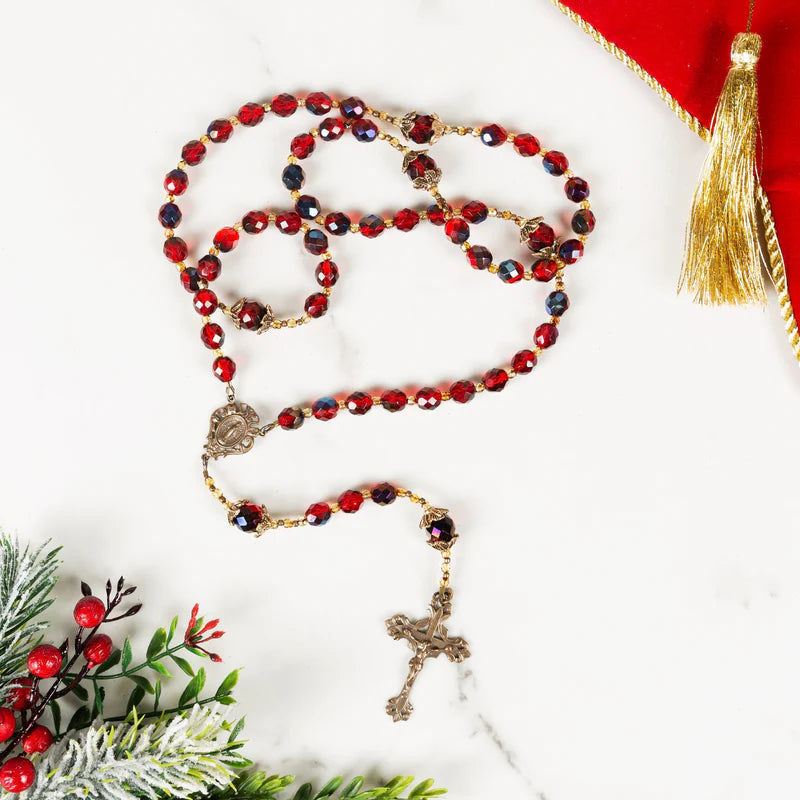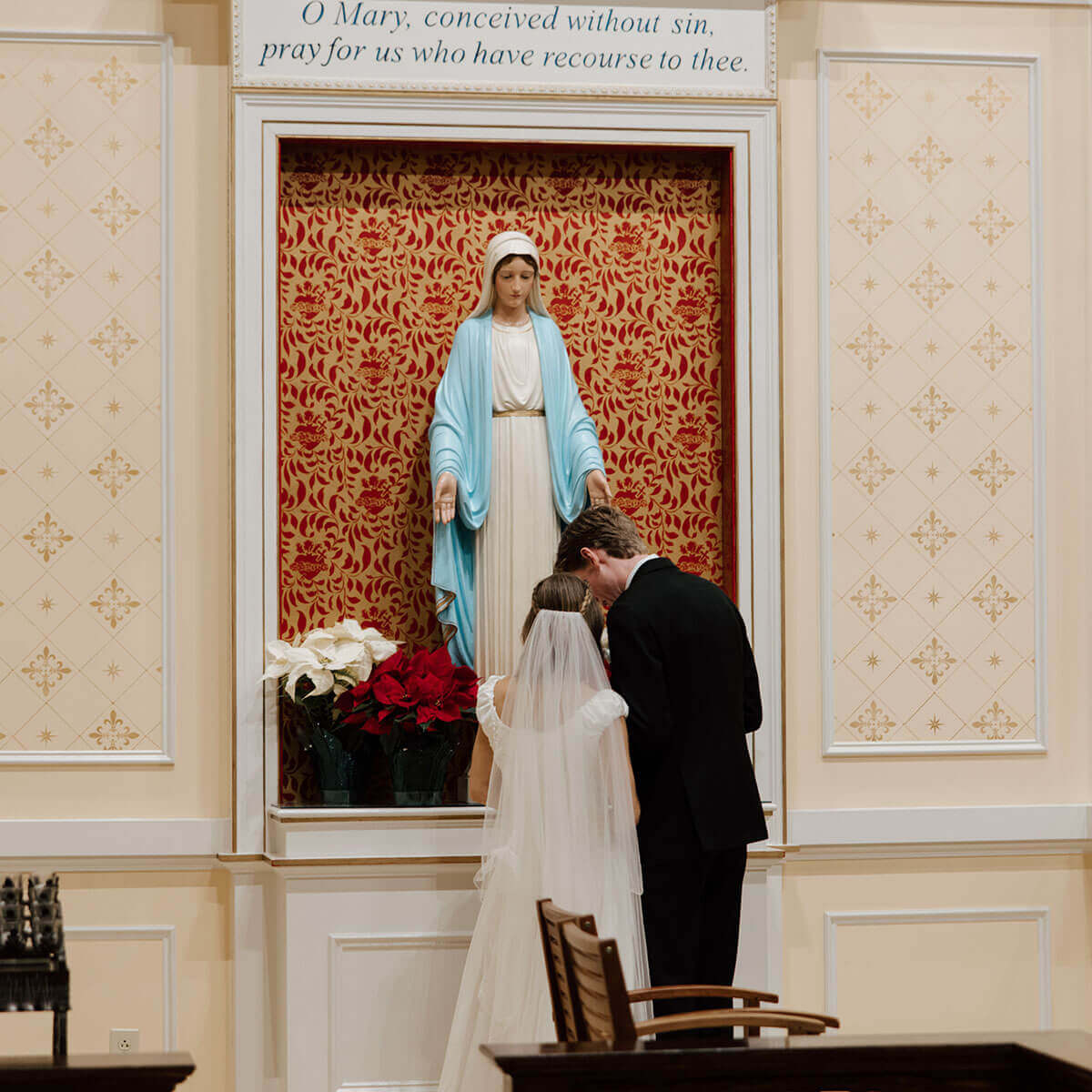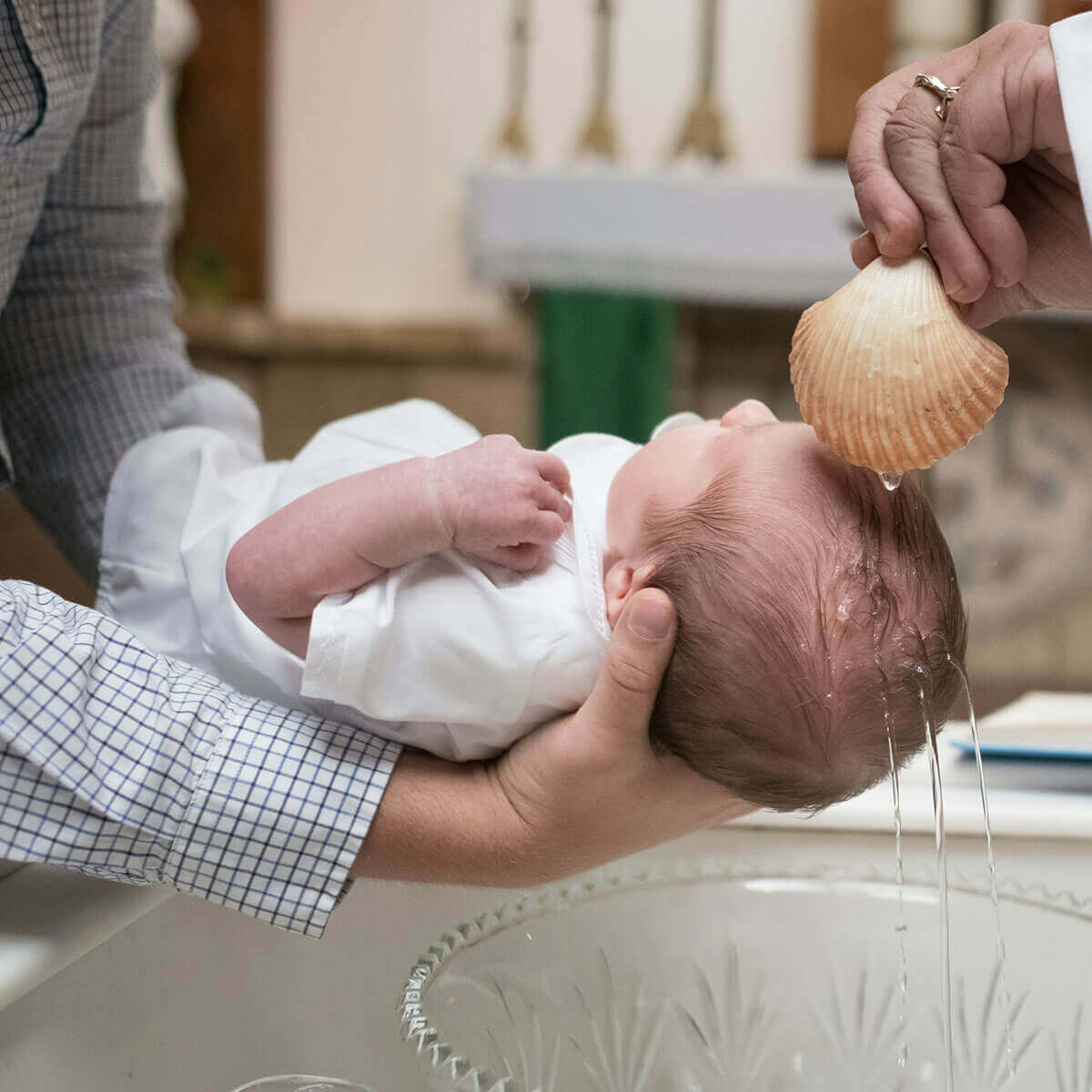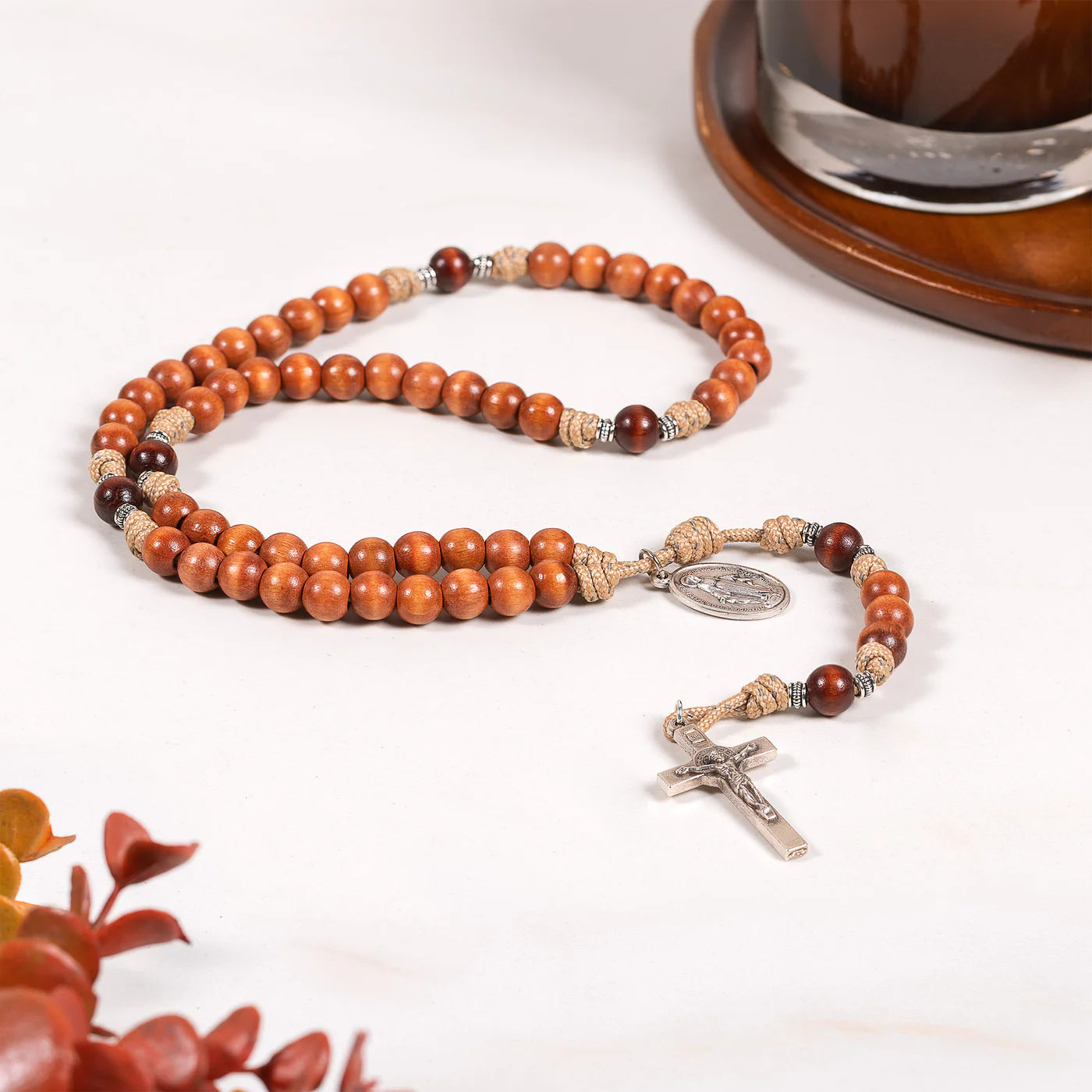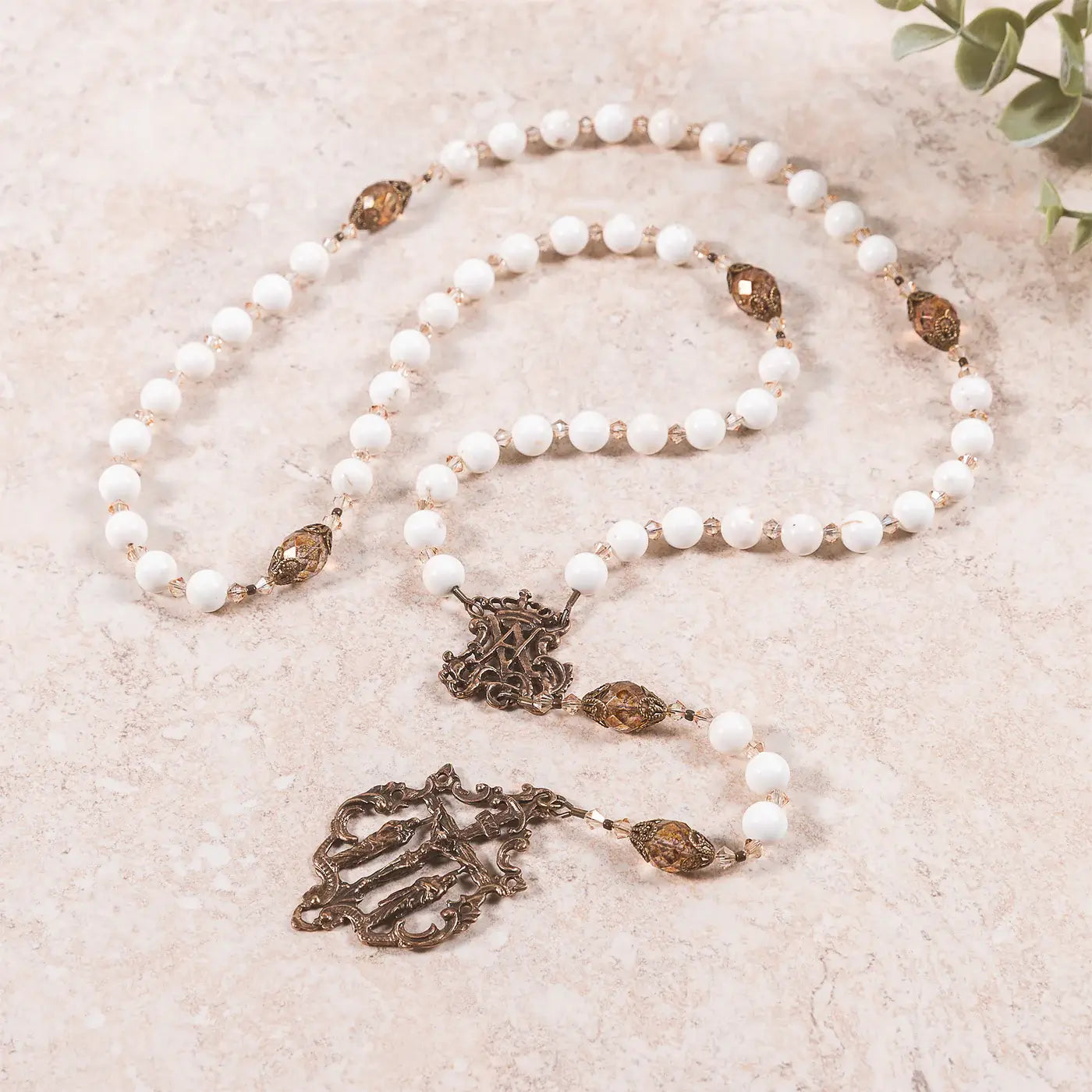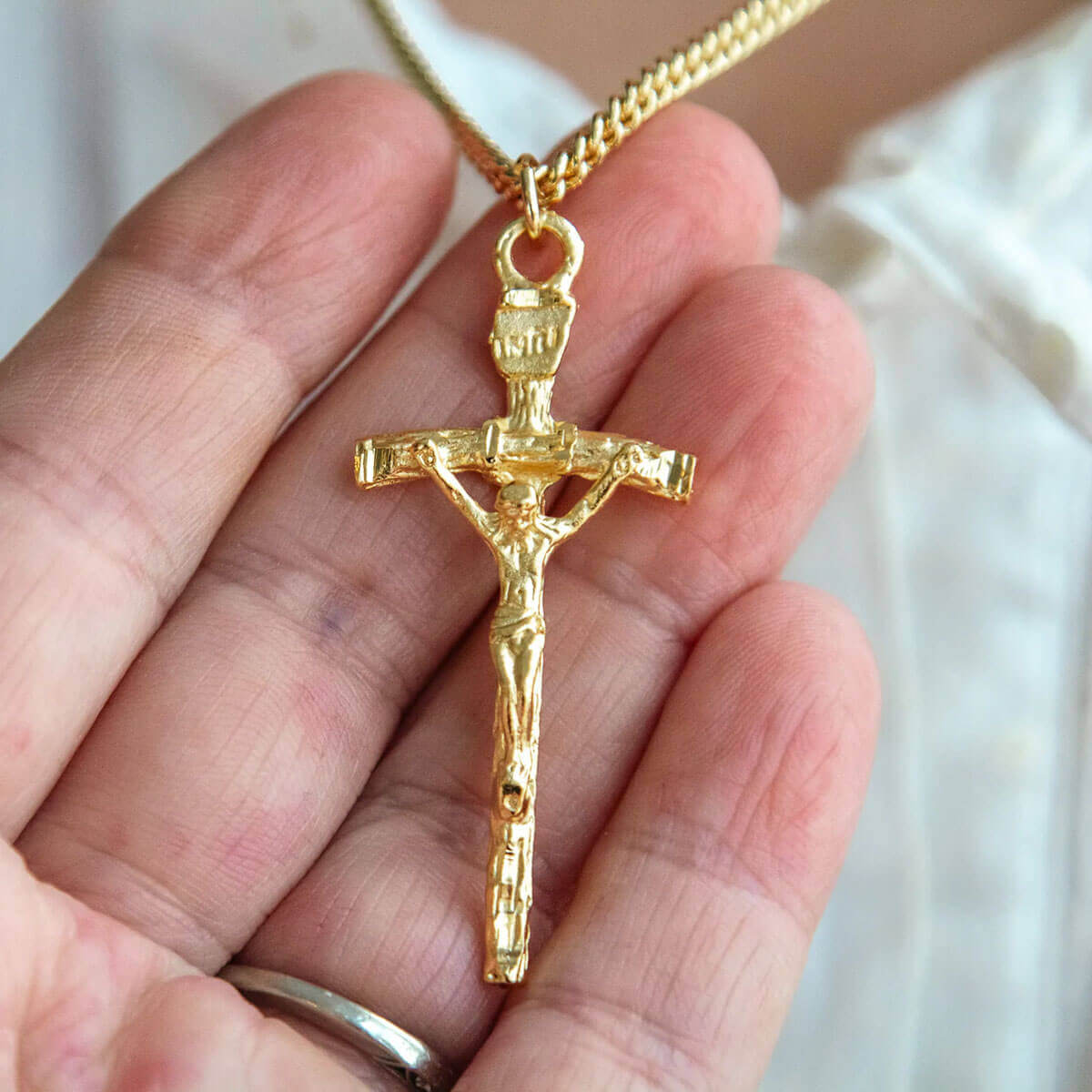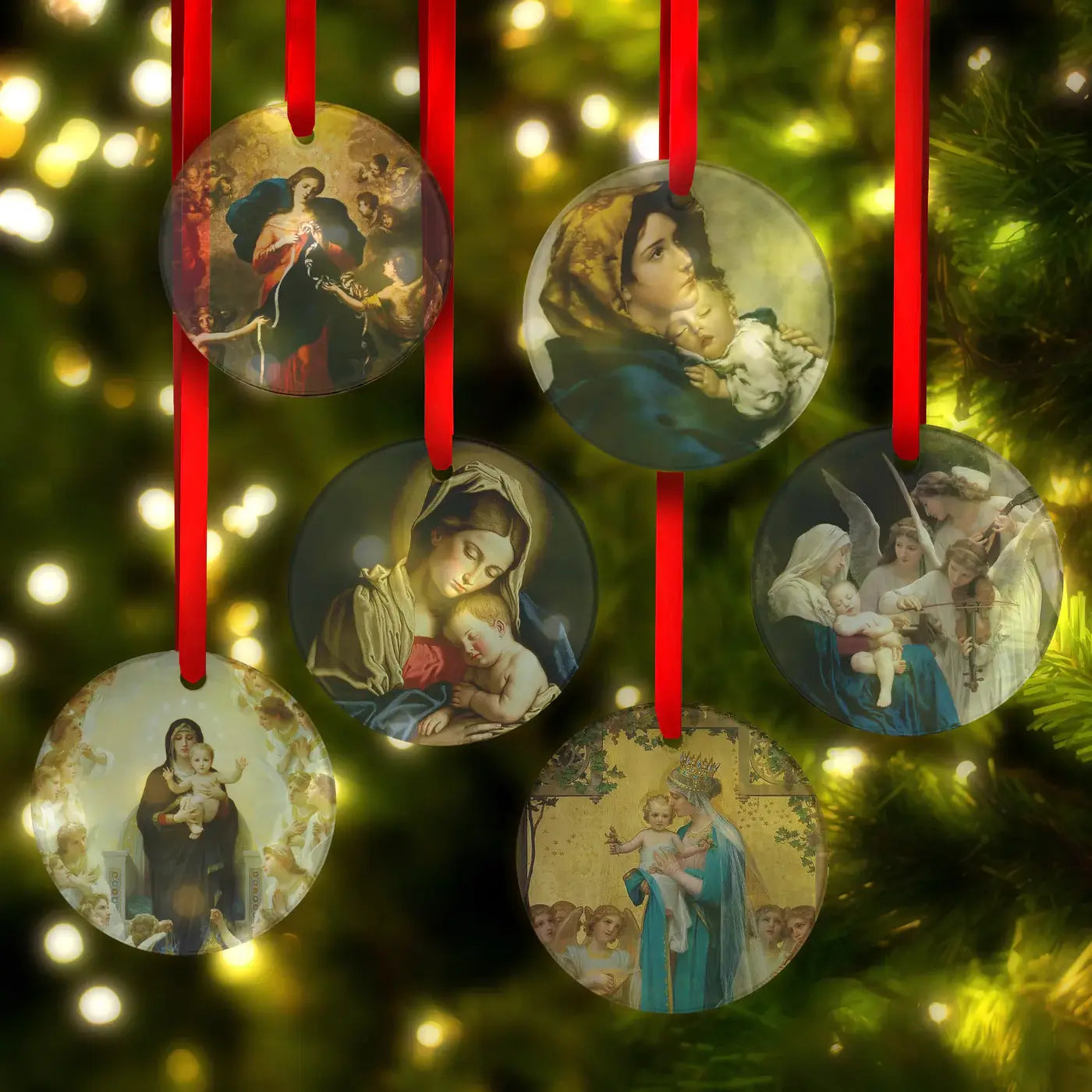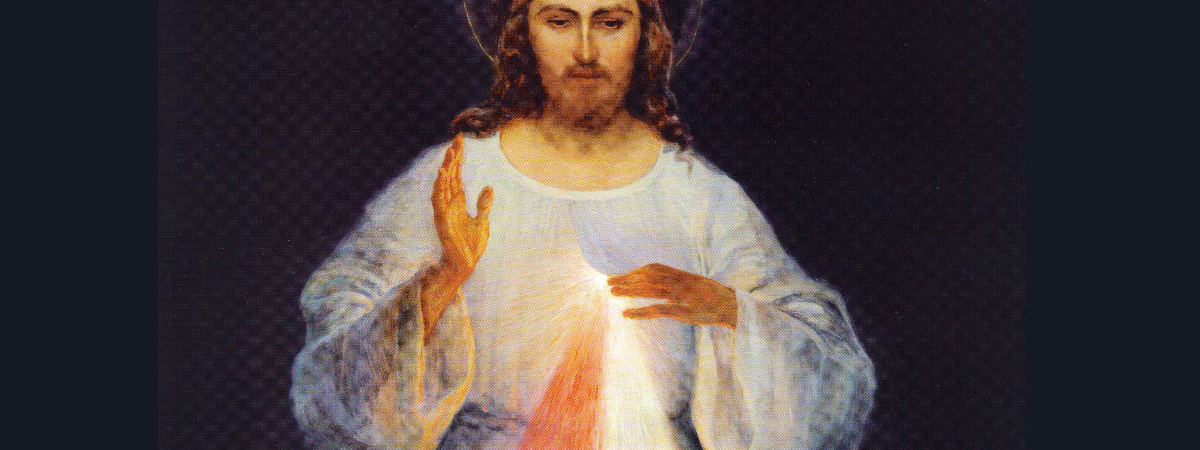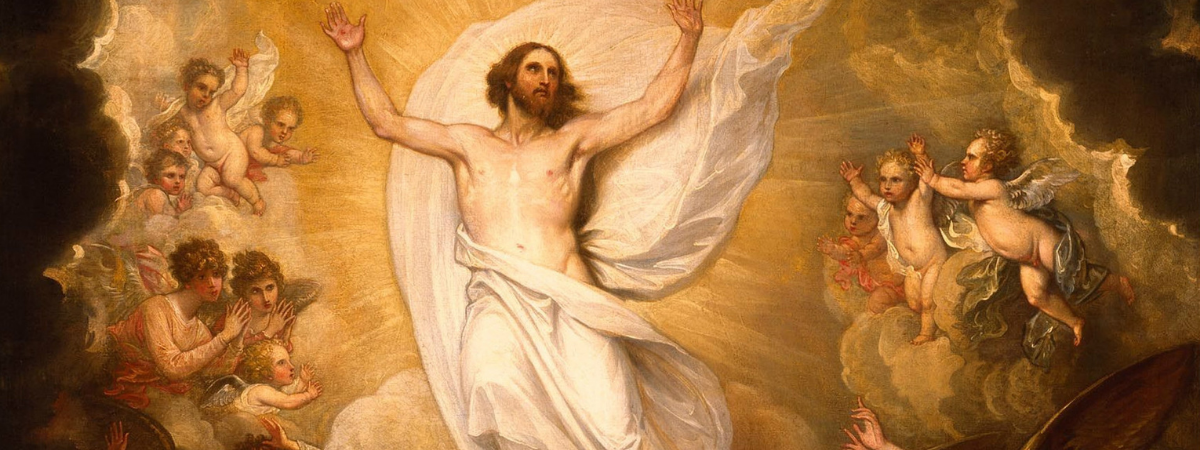The Divine Mercy devotion is a modern devotion to the attribute of God's infinite mercy that was promulgated by St. Faustina Kowalska in Poland, and later to the the Universal Church by Pope St. John Paul II ("The Mercy Pope").
The Divine Mercy Devotion
This devotion is multifaceted and has many different components: it involves a divinely inspired painting of Jesus with attached promises for its veneration, vocal prayers (the Divine Mercy chaplet and Divine Mercy Novena), a book (The Diary of Faustina Kowalska), a Holy Hour (3 o'clock), and a solemn feast day with attached indulgences (Divine Mercy Sunday).
SAINT FAUSTINA
Shortly before the outbreak of World War II, a simple, young, uneducated Polish nun received a special calling. On the night of Sunday, February 22, 1931, while she was in her cell, Jesus appeared to Sister Faustina as the "King of Divine Mercy." He was wearing a white garment with red and pale rays emanating from his Sacred Heart. He would continue to appear and speak to her, and for four years St. Faustina recorded Jesus' words, her visions, and her own thoughts and prayers in a personal diary.
Jesus gave St. Faustina a special mission, telling her, "I am sending you with My mercy to the people of the whole world. I do not want to punish mankind, but I desire to heal it, pressing it to My merciful Heart." He also said to her, "You are the secretary of My Mercy. I have chosen you for that office in this and the next life." In visions that followed, Jesus asked Saint Faustina to be His instrument for spreading the message of His Mercy to all the world.
THE DIARY
These words of Jesus are found in the widely read and loved Diary of St. Maria Faustina Kowalska, which chronicles Sister Faustina's great experience of the work of Divine Mercy in her own soul, and her mission to share that mercy with the world. Jesus chose St. Faustina as the Apostle and "Secretary" of His Mercy, so that she could tell the world about His great message, which she faithfully recorded in a diary. St. Faustina, who may one day be regarded as one of the Church's great mystics, exemplified a childlike trust, simplicity, and profound intimacy with Christ. Nearly a million copies of this diary have been sold worldwide, bringing consolation to many souls and leading them to greater trust in Jesus.
THE IMAGE
The earliest element of the devotion to the Divine Mercy revealed to St. Faustina was the painted image. She writes, "In the evening, when I was in my cell, I became aware of the Lord Jesus clothed in a white garment. One hand was raised in blessing, the other was touching the garment at the breast. From the opening of the garment at the breast there came forth two large rays, one red and the other pale. In silence I gazed intently at the Lord; my soul was overwhelmed with fear, but also with great joy. After a while Jesus said to me,
'Paint an image according to the pattern you see, with the signature: Jesus I trust in You. I desire that this image be venerated, first in your chapel, and throughout the world.'" (Diary 47)
She also records the following words of Jesus in relation to the image he commissioned her to have painted and venerated:
"I promise that the soul that will venerate this image will not perish. I also promise victory over its enemies already here on earth, especially at the hour of death. I myself will defend it as My own glory." (Diary 48)
"I am offering people a vessel with which they are to keep coming for graces to the fountain of mercy. That vessel is this image with the signature: Jesus, I trust in You." (Diary 327)
"The two rays denote Blood and Water. The pale ray stands for the Water which makes souls righteous. The red ray stands for the Blood which is the life of souls. These two rays issued forth from the very depths of My tender mercy when My agonized heart was opened by a lance on the Cross. These rays shield souls from the wrath of My Father. Happy is the one who dwell in their shelter, for the just hand of God shall not lay hold of him." (Diary 299)
"Not in the beauty of the color, nor of the brush, lies the greatness of this image, but in My grace." (Diary 313)
"By means of this image I shall grant many graces to souls. It is to be a reminder of the demands of My mercy, because even the strongest faith is of no avail without works." (Diary 742)
THE CHAPLET
Jesus also taught St. Faustina prayers to implore his Divine Mercy. You can find a visual guide for how to pray the Divine Mercy Chaplet here.
Using regular rosary beads, you begin the chaplet with an 'Our Father', 'Hail Mary', and 'I believe' (the Apostle's Creed). Then on the large (Our Father) beads say the following words:
'Eternal Father, I offer You the Body and Blood, Soul and Divinity of Your dearly beloved Son, Our Lord Jesus Christ, in atonement for our sins and those of the whole world.'
On the smaller (Hail Mary) beads pray:
'For the sake of His sorrowful Passion have mercy on us and on the whole world.'
In conclusion pray these words three times:
'Holy God, Holy Mighty One, Holy Immortal One, have mercy on us and on the whole world'.
Jesus said later to Sister Faustina:
"Say unceasingly this chaplet that I have taught you. Anyone who says it will receive great Mercy at the hour of death. Priests will recommend it to sinners as the last hope. Even the most hardened sinner, if he recites this Chaplet even once, will receive grace from My Infinite Mercy. I want the whole world to know My Infinite Mercy. I want to give unimaginable graces to those who trust in My Mercy" and later, "When they say this Chaplet in the presence of the dying, I will stand between My Father and the dying person not as the just judge but as the Merciful Savior".
THE NOVENA
Another request of Jesus to St. Faustina was for a special feast day devoted to the attribute of his Divine Mercy. He asked that the Feast of Divine Mercy be preceded by a Novena to the Divine Mercy which would begin on Good Friday. He gave St. Faustina an intention to pray for on each day of the novena, the last day being the most difficult intention of all . . . those who are lukewarm and indifferent to his merciful love. Of these people, Jesus said,
"These souls cause Me more suffering than any others; it was from such souls that My soul felt the most revulsion in the Garden of Olives. It was on their account that I said: 'My Father, if it is possible, let this cup pass Me by.' The last hope of salvation for them is to flee to My Mercy."
In her Diary, St. Faustina wrote that Jesus told her:
"On each day of the novena you will bring to My heart a different group of souls and you will immerse them in this ocean of My mercy ... On each day you will beg My Father, on the strength of My passion, for the graces for these souls."
The different souls prayed for on each day of the novena are:
DAY 1 (Good Friday) - All mankind, especially sinners
DAY 2 (Holy Saturday) - The souls of priests and religious
DAY 3 (Easter Sunday) - All devout and faithful souls
DAY 4 (Easter Monday) - Those who do not believe in Jesus and those who do not yet know Him
DAY 5 (Easter Tuesday) - The souls of separated brethren
DAY 6 (Easter Wednesday) - The meek and humble souls and the souls of children
DAY 7 (Easter Thursday) - The souls who especially venerate and glorify Jesus' mercy
DAY 8 (Easter Friday) - The souls who are detained in purgatory
DAY 9 (Easter Saturday) - The souls who have become lukewarm
During the Divine Mercy Novena leading up to Divine Mercy Sunday, the Chaplet of Divine Mercy should be prayed each day for that day's intentions.
Of course, this novena can also be prayed year-round whenever we want to entrust a particular intention to Jesus' mercy.
Read next How to Pray the Divine Mercy Novena

THE HOLY HOUR
Jesus also told St. Faustina that the hour He expired on the cross is the hour in which to especially implore the attribute of his Divine Mercy, because at that moment his saving mission was accomplished and his blood and water was poured out on the cross for the sins of the whole world. Because Jesus made the 3 o'clock hour sacred, whenever the clock strikes this hour, his mercy can be efficaciously implored.
"At three o'clock, implore My mercy, especially for sinners; and, if only for a brief moment, immerse yourself in My Passion, particularly in My abandonment at the moment of agony. This is the hour of great mercy ... In this hour I will refuse nothing to the soul that makes a request of Me in virtue of My Passion." (Diary 1320).
"As often as you hear the clock strike the third hour immerse yourself completely in My mercy, adoring and glorifying it, invoke it's omnipotence for the whole world, and particularly for poor sinners, for at that moment mercy was opened wide for every soul. In this hour you can obtain everything for yourself and for others for the asking; it was the hour of grace for the whole world - mercy triumphed over justice."
"Try your best to make the Stations of the Cross in this hour, provided that your duties permit it; and if you are not able to make the Stations of the Cross, then at least step into the chapel for a moment and adore, in the Most Blessed Sacrament. My Heart, which is full of mercy: and should you be unable to step into chapel. immerse yourself in prayer there where you happen to be, if only for a very brief instant." (Diary 1572)
DIVINE MERCY SUNDAY
Jesus requested that a special feast devoted to his Divine Mercy take place on the octave day of Easter (the second Sunday of Easter), a day in which he would pour special graces out on the whole world. Jesus grants an indulgence (either full or partial remission for the temporal punishment of sin) for all who will participate in this feast and implore his Divine Mercy.
"Whoever approaches the Fountain of Life on this day will be granted complete forgiveness of sins and punishment." (Diary 300)
"I want the image solemnly blessed on the first Sunday after Easter, and I want it to be venerated publicly so that every soul may know about it." (Diary 341)
"This Feast emerged from the very depths of My mercy, and it is confirmed in the vast depths of my tender mercies." (Diary 420)
"My daughter, tell the whole world about My Inconceivable mercy. I desire that the Feast of Mercy be a refuge and shelter for all souls, and especially for poor sinners. On that day the very depths of My tender mercy are open. I pour out a whole ocean of graces upon those souls who approach the fount of My mercy. The soul that will go to Confession and receive Holy Communion shall obtain complete forgiveness of sins and punishment.
On that day all the divine floodgates through which grace flow are opened. Let no soul fear to draw near to Me, even though its sins be as scarlet. My mercy is so great that no mind, be it of man or of angel, will be able to fathom it throughout all eternity. Everything that exists has come forth from the very depths of My most tender mercy. Every soul in its relation to Me will I contemplate My love and mercy throughout eternity. The Feast of Mercy emerged from My very depths of tenderness. It is My desire that it be solemnly celebrated on the first Sunday after Easter. Mankind will not have peace until it turns to the Fount of My Mercy." (Diary 699)
"I want to grant complete pardon to the souls that will go to Confession and receive Holy Communion on the Feast of My mercy." (Diary 1109)
"Yes, the first Sunday after Easter is the Feast of Mercy, but there must also be deeds of mercy, which are to arise out of love for Me. You are to show mercy to our neighbors always and everywhere. You must not shrink from this or try to absolve yourself from it." (Diary 742)
In response to Jesus' request for a feast honoring his Divine Mercy on the first Sunday after Easter, the Vatican has greatly encouraged the faithful to make use of this devotion and has issued the official conditions for how to obtain this Divine Mercy Sunday indulgence:
A plenary indulgence, granted under the usual conditions (sacramental confession, Eucharistic communion and prayer for the intentions of Supreme Pontiff) to the faithful who, on the Second Sunday of Easter or Divine Mercy Sunday, in any church or chapel, in a spirit that is completely detached from the affection for a sin, even a venial sin, take part in the prayers and devotions held in honour of Divine Mercy, or who, in the presence of the Blessed Sacrament exposed or reserved in the tabernacle, recite the Our Father and the Creed, adding a devout prayer to the merciful Lord Jesus (e.g. Merciful Jesus, I trust in you!");
A partial indulgence, granted to the faithful who, at least with a contrite heart, pray to the merciful Lord Jesus a legitimately approved invocation.
THE DIVINE MERCY POPE
Though she died in obscurity on October 5, 1938 (a year before Germany invaded Poland, the start of WWII), Sr. Faustina was hailed by Pope St. John Paul II as "the great apostle of Divine Mercy in our time." On April 30, 2000, the Pope canonized her a saint, saying that the message of Divine Mercy she shared is urgently needed at the dawn of the new millennium. In fact, St. Faustina was the first canonized saint of the new millennium.
During the time that St. Faustina received the messages from Our Lord, Karol Wojtyla was forcibly working in a factory during the Nazi occupation of Poland, which was in view of St. Faustina's convent.
The knowledge of St. Faustina's revelations became known to Pope John Paul II early in 1940 when he was secretly studying for the priesthood in a Krakow seminary. Karol Wojtyla visited the convent frequently, first as a priest and then as bishop.
It was Karol Wojtyla, as Archbishop of Krakow, who, after St. Faustina’s death, was the first to consider bringing St. Faustina’s name before the Congregation for the Causes of Saints for beatification.
In 1980 Pope John Paul II published his encyclical letter “Dives in Misericordia” (Rich in Mercy) calling on the Church to devote herself to pleading for God's mercy on the whole world. Pope John Paul II said that he felt spiritually very near to Saint Faustina and had been thinking about her and the message of Divine Mercy when he began ‘Dives in Misericordia’.
On April 30, 2000, that year the Sunday following Easter, Pope John Paul II canonized Saint Faustina Kowalska before some 250,000 pilgrims. He also approved the Divine Mercy message and devotion by declaring the Second Sunday of Easter as "Divine Mercy Sunday" for the universal Church.
In one of his most extraordinary homilies, Pope St. John Paul II repeated three times that Saint Faustina is "God's gift to our time." She made the message of Divine Mercy the "bridge to the third millennium." He then said, “By this act of canonization of Saint Faustina I intend today to pass this message on to the third millennium. I pass it on to all people, so that they will learn to know ever better the true face of God and the true face of their neighbor. In fact, love of God and love of one's neighbor are inseparable."
Pope John Paul II died on the vigil of Divine Mercy Sunday in April 2005, and was canonized by Pope Francis on Divine Mercy Sunday, April 27, 2014. Pope Francis then carried on the Divine Mercy message by instituting the Jubilee Year of Mercy, which was especially devoted to the spiritual and corporal works of mercy, in 2016.
Do you have a special devotion to Jesus' Divine Mercy? If so, please share the graces you have received in the comments below!

This article has been updated and was originally published in April 2014. © The Catholic Company. All rights reserved.


